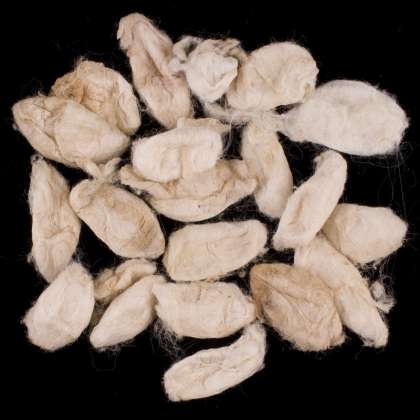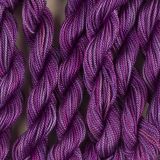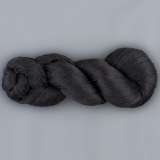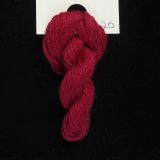Wild Silk Cocoons - Eri (white) - 7g
The Philosamima ricini wild silk worm spins eri silk. When this silkworm spins his cocoon, he spins for a while, then takes a break, repeating this process several times until his cocoon is completed. Because of these breaks, the cocoon is not one continuous filament as you'll find with the other cocoons, so eri silk is seldom reeled.
To be able to import these valuable wild silk cocoons from India, the cocoon has been slit and the pupa removed. They are terrific for educational purposes.
The cocoons are not treated with any chemicals.
Unlike the other silk worms that produce one continuous strand of silk while creating its cocoon, the eri silk worm starts and stops during the three day process. This causes breaks in the silk strand, making it undesirable to reel the silk.
Eri silk has less sericin (the protein ‘glue’ that protects the silk and holds the silk together in its cocoon shape) than other types of silk, so the eri cocoon has a fuzzy texture. Click here to see eri cocoons.
Eri silk is less lustrous than bombyx mori silk, making it less popular with people seeking the traditional high-sheen of silk.
Treenway Silks has used the same silk supplier in India for over 15 years and he consistently delivers top quality.
Color: natural white
7g (approximately 10 cocoons)
PEACE SILK? not really.
Silk is an eco-friendly product.
- Ahimsa silk is a patented term referring to an eco-friendly method of manufacturing spun mulberry silk
- Eri silk could be peace silk, but most likely it is not, as almost always the pupa is removed for feeding people or other animals
- Don't assume that because tussah, muga and eri silk are wild silks they are peace silks--muga and tussah are also reeled and the eri pupae are used for food--so check your sources.
- The only true peace silk is made from cocoons in which the pupa has matured into a moth. Most often this is for breeding purposes, and the quantity of this type of silk is very small.
- The caterpillars produced from the eggs resulting from all the matings from unstilfed cocoons (200 to 500 eggs per moth) would not have enough food and they would die from starvation and neglect.
- Sericulture is a sustainable, renewable, environmentally friendly resource that gives million of rural people a healthy, family-oriented lifestyle.






